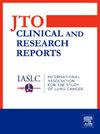Access to Diagnostics and Treatment for People With Metastatic EGFR-Positive NSCLC: Lessons From Project PRIORITY
IF 3
Q2 ONCOLOGY
引用次数: 0
Abstract
Introduction
The treatment landscape for people diagnosed with EGFR-mutated (EGFR-m) NSCLC has rapidly evolved, yet there remains limited self-reported information about the lived experience. In this paper, we describe the clinical characteristics and treatment experiences of people living with EGFR-m lung cancer from Project PRIORITY, a patient-driven study.
Methods
An online survey was distributed among the EGFR Resisters community between April 2019 and January 2020. The survey captured participants’ demographics and lung cancer risk factors, diagnostic and treatment pathways, and prevalence of side effects. Descriptive statistics were used and included subgroups based on residency and cancer stage.
Results
Of the 425 participants, most were female (67%), under 60 years old (53%), and resided in the United States (74%). The most frequently reported symptom at diagnosis was cough (54%), though 18% reported no symptoms. In addition, 89% reported receiving at least one tyrosine kinase inhibitor (TKI); osimertinib was the most prescribed first-line TKI for stage IV participants diagnosed after 2017. Participants residing in the United States were more likely to have access to advanced diagnostic (next-generating sequencing) and newer treatments such as osimertinib. Just under half of the sample (47%) had experienced progressive disease and were no longer on first-line treatment.
Conclusion
The TKI era has been practice changing; however, little is understood from the perspective of people living with EGFR-m NSCLC. This paper is the first to explore this and found it is possible to have people self-report complex health information about their lung cancer. In addition, although most participants were diagnosed after osimertinib became guideline-recommended treatment, disparities in treatment were identified.
转移性egfr阳性非小细胞肺癌的诊断和治疗:来自项目优先级的经验教训
egfr突变(EGFR-m)非小细胞肺癌的治疗前景迅速发展,但关于生活经历的自我报告信息仍然有限。在本文中,我们描述了来自Project PRIORITY的EGFR-m肺癌患者的临床特征和治疗经验,这是一项患者驱动的研究。方法于2019年4月至2020年1月在EGFR抵抗者社区进行在线调查。该调查收集了参与者的人口统计数据、肺癌风险因素、诊断和治疗途径以及副作用的发生率。使用描述性统计,并根据居住和癌症分期纳入亚组。在425名参与者中,大多数是女性(67%),60岁以下(53%),居住在美国(74%)。诊断时最常报告的症状是咳嗽(54%),尽管18%报告无症状。此外,89%的患者报告接受了至少一种酪氨酸激酶抑制剂(TKI);奥西替尼是2017年之后诊断为IV期患者的一线TKI处方最多的药物。居住在美国的参与者更有可能获得先进的诊断(下一代测序)和新的治疗方法,如奥西替尼。不到一半的样本(47%)经历了进行性疾病,不再接受一线治疗。结论TKI时代正在经历实践变革;然而,从EGFR-m非小细胞肺癌患者的角度来看,人们知之甚少。这篇论文首次对此进行了探索,并发现让人们自我报告有关肺癌的复杂健康信息是可能的。此外,虽然大多数参与者是在奥西替尼成为指南推荐治疗后被诊断出来的,但治疗差异被确定。
本文章由计算机程序翻译,如有差异,请以英文原文为准。
求助全文
约1分钟内获得全文
求助全文
来源期刊

JTO Clinical and Research Reports
Medicine-Oncology
CiteScore
4.20
自引率
0.00%
发文量
145
审稿时长
19 weeks
 求助内容:
求助内容: 应助结果提醒方式:
应助结果提醒方式:


